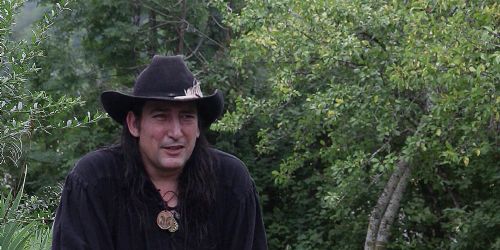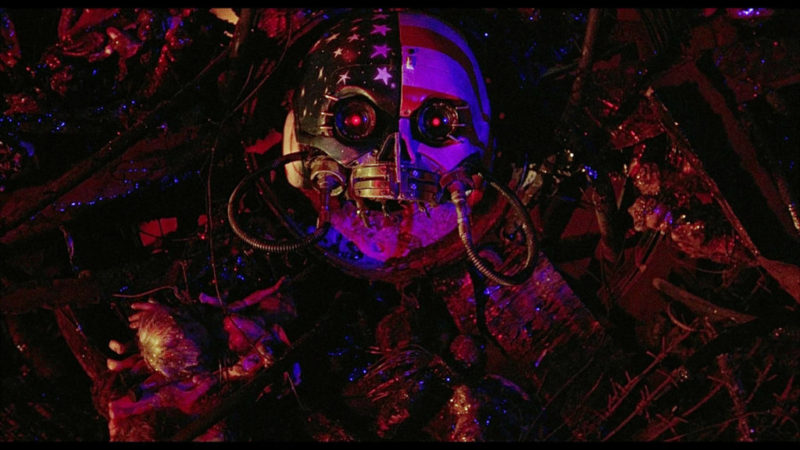After many moons of not having the visionary Richard Stanley sit in the Director’s Chair for a feature film, the Universe (and SpectreVision) has heeded to so many of our cries. Stepping back into the limelight and delivering one of his passion projects, Stanley presents a dazzling cinematic rendering of Color Out of Space from a short story of the same name, penned by H.P. Lovecraft. He breathes incredible life, horror and yes, color, into this tale that is ages old.
I was able to chat with the magical movie maker recently, thirty years after he helped introduce me to a whole new world with his film Hardware. We discuss the lore of Lovecraft, working with digital effects in such a spectacular capacity, and how his documentary, The Otherworld (which also features Color Out of Space co-writer, Scarlett Amaris) is an important precursor to his latest offering.

RS: Thanks for talking.
PH: Thank you so much for your time! It’s an honor to speak with you, Mr. Stanley, and to tell you that I thoroughly, thoroughly enjoyed Color Out of Space! I actually drove from Phoenix to LA to catch it at Beyond Fest in September, so I’ve been able to experience it on the big screen as well as at home via screener. So thank you.
RS: Wow. Well, thank you for going out of your way. That’s incredible.
PH: My pleasure. You mentioned at Beyond Fest that as a young boy, your mother would read you tales from Lovecraft. Did you feel a special connection to making Color Out of Space because of this?
RS: Yes. Color Out of Space was a way of repaying the debts to my mother, and Lovecraft. It certainly indoctrinated me into the Lovecraftian universe as a child and changed the way I saw my life. I certainly have a lot to thank Lovecraft.
PH: How did it feel to say “Action” on the first take?
RS: It felt strangely natural. I think I’ve got some kind of director’s software in my brain. It sort of kicks in. It’s like muscle memory. It’s really odd. Initially, I didn’t know where I was going, but after the first couple of days when the rushes started to look good, I was able to lead into in that, and some autopilot thing more or less just kept telling me where to go, more or less, and what to do next. It was nice to know it was still functioning, whatever that good stuff is.

PH: Well it looked pretty natural to me watching it up on the big screen. So this wasn’t the first time you’d collaborated with Scarlett Amaris. What is it that makes you two such a dynamic team?
RS: This whole incident came out of an episode many years ago when me and Scarlett had bought a glow-in-the-dark Ouija board at Toys R Us. We were experimenting with the Ouija board, and the Ouija board told us to make a short movie out of a Clark Ashton Smith story, The Mother of Toads.
PH: Oh, yeah! From Theatre Bizarre.
RS: That’s right, yeah. It was a glow-in-the-dark Ouija board from Toys R Us that told us to do it, directed us as to how to write the story, as far as what we were going to do. The Ouija board directed us to adapt the story. Then David Gregory was putting together the Theatre Bizarre project so we turned in the 20-page script, and he gave us $20,000 to shoot The Mother of Toads. Then the backer of Theatre Bizarre was sufficiently impressed with The Mother of Toads segment that he said, ‘Why don’t you write a feature length adaptation of a Lovecraft story. HP Lovecraft work was in public domain. They suggested they would pay us to write an adaptation. We ended up settling down and writing the first draft of Color Out of Space.
PH: Going into another project that you worked with Scarlett on, Tommy Chong’s character Ezra reminded me of your pal Uranie, from the documentary The Otherworld, kind of as well as the respect given to things that are greater than ourselves. Is Color Out of Space perhaps a cinematic spiritual cousin to The Otherworld?

RS: Completely. I’m glad you’ve seen that. Not many people do. But yeah, for anyone who enjoys Color Out of Space, I would strongly advise them to track down a copy of The Otherworld because it does provide context. Quite a few of the things that happen in Color Out of Space are drawn from real life characters and first hand stories that we’ve come across during the time that we’ve been living here in The Pyrenees in the South of France. Uranie, in real life, was a bush shaman, French witch doctor character.
To put it as briefly as possible, Uranie actually believed in the existence of HP Lovecraft’s Old Ones and had a French language copy of the Necronomicon. In fact, he did a Lovecraft invocation to make Color Out of Space happen. Weirdly, Uranie died of liver failure just before Color Out of Space happen so I hope his life wasn’t the price that was paid to bring the movie into existence. The Tommy Chong character in the film is strongly based on Uranie, and we tried to recreate Uranie’s cottage in the forest. He’s also fused with another real life character who was another wild person living at the top of the river here in the valley where I live, who back in the late 1990s made analog audio recordings of what he believed were aliens moving about. He eventually played these audio recordings of the alleged aliens on French national television in 2012, which led to an outbreak of mass hysteria in the area which led to the French military having to declare martial law in the entire area so yeah, some elements of Color Out of Space are based on crazy, real life experiences.
PH: That documentary was life altering for me. I watch it frequently and I always tell people to check it out. It’s something spectacular. But so is Color Out of Space, and that’s why I wanted to ask you that question. It just felt like a natural progression of The Otherworld, and knowing that your mom lovingly told you tales from him too, that this has been a passion project for you, kind of, all your life.

RS: I think HP Lovecraft gave me some tools where I have ended up seeing the world in a slightly different way from other folks.
PH: Absolutely and I admire that and thank you. Something else I noticed during the movie too, ‘No Flesh Shall Be Spared’ was on Benny’s bedroom wall, and I’m wondering, was that a nod to your incredible film Hardware from ‘90? I know it’s also a biblical verse. Why was it incorporated into Color Out of Space?
RS: It’s to keep that theme going. It’s a nod back to the Book of Mark, Chapter 13 in which it’s all kind of unfolding, which is a biblical apocalyptic reference. Something that I hope I’ll be returning to in another couple of movies.
PH: Are you working on anything else right now?
RS: Right now we’re prepping the next Lovecraft movie because Color Out of Space is now going to be the first entry in a projected trilogy.
PH: Beautiful. I was hoping that wasn’t just a rumor.
RS: No. Currently prepping on a new adaptation of The Dunwich Horror.
PH: I am so excited for all of this!
RS: This time without Dean Stockwell. There’s been previous versions, both with Dean Stockwell. He won’t be in this one.
PH: Unfortunately….. no. You mentioned also at Beyond Fest, that this was your first time playing in the “digital sandbox”. How was that for you?
RS: It was certainly a delight getting my hand into the toy box as such because that option never existed back in the day when I was directing 35 mm movies. I think it’s clearly a medium that opens up a lot of possibilities for the genre. Gives me the chance to literally get into the grain of the shot, try to heighten the sense of… we’re literally pushing against the fabric of reality in some sequences. So I’m really hoping that we’ll be able to improve on some of the sequences or temperatures of color deep in the exploration of the Lovecraftian universe in the next movie. We had very little money to play with on Color so much of what we achieved is thanks to an extraordinary effects team which gave the film an almost studio look.
PH: Color Out of Space is an incredible experience! Just one last thing, Richard. I just have to tell you that when I was a kid, my dad took me to see Hardware. I was actually only 10 years old.

RS: Oh, man. That is way too young!
PH: Yeah, he was so embarrassed that he took a kid to see that, that he made me hide underneath the theater seats afterward. But he realized that I fucking loved it. And then he went on to really encourage my love of the genre. So this means so much to me – thank you.
RS: I’m so pleased to hear that. That’s much too young. My real life nephew Benny, who is the basis of Benny in the movie, also saw Hardware when he was about 10, and I asked what he thought about it. I was freaked out he’d seen it, and he said he didn’t think it was as good as Predator.
PH: Yikes! Tough crowd he was. Thank you so much for your time. Cheers!
RS: Take care.
*** It was such a pleasure talking with Richard Stanley! Be sure to check out Color Out of Space when it hits theaters on Friday, January 24th, 2020!
 PopHorror Let's Get Scared
PopHorror Let's Get Scared




